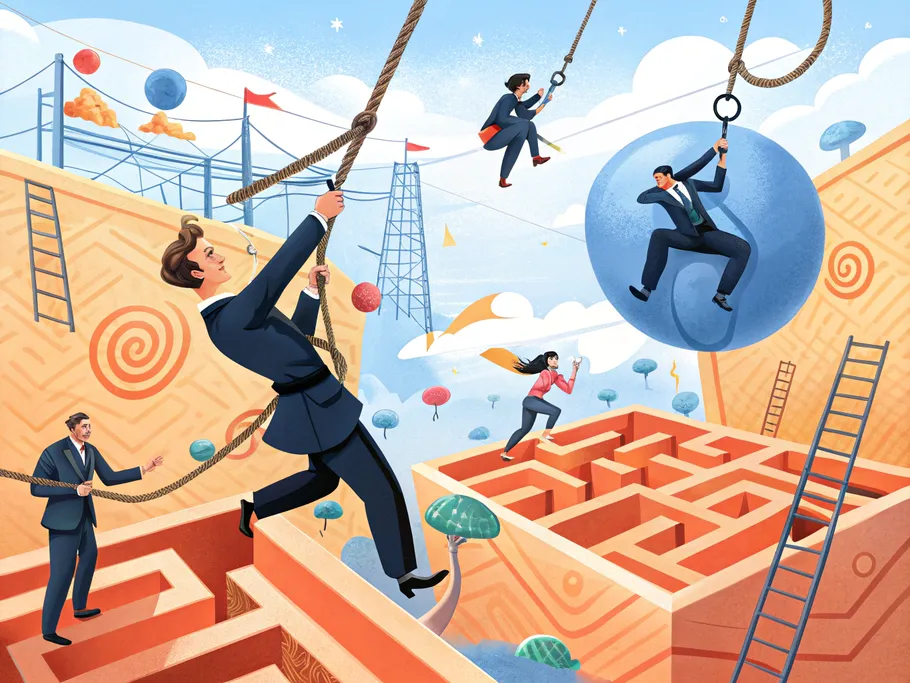B2B isn’t just a boring acronym – it’s an arena where companies try to outsmart each other into “investing” in their solutions.
Forget the idea that businesses just “spend” money when buying from you.
No, no – they invest it!
And if you want a slice of their cash pie, you’d better show them the money (preferably in a spreadsheet, because nothing screams trust like a good old ROI formula).

B2B sales is where you’re pitching not to one skeptical person, but a whole room of them, all desperate not to get fired. B2B is about convincing a committee, not a single impulse shopper.
Still clinging to the old B2B vs B2C labels? The market melted those lines while you were updating your org chart. It’s not just about who’s buying.
B2B companies sell goods or services to other businesses. Simple, right? Not anymore. Thanks to digital transformation, B2B is now a choose-your-own-adventure, with hybrids like B2B2C (Business-to-Business-to-Consumer) popping up. Here, your client might be another business, but the end user could be just about anyone.
Now, business deals are less about quick transactions and more about partnership, co-creation, and making everyone look good in the quarterly review.
Tech is shaking up B2B operations: platforms, analytics, AI, and cloud computing are blurring the lines with B2C.
Think your B2B buyers are immune to consumer habits? They bought groceries online this morning. Get your shit together.
B2B clients now expect the same digital smoothness as their favorite online shops. If you’re not investing in digital marketing, e-commerce, and data-driven decision-making, you’re basically bringing a butter knife to a gunfight.
B2B companies usually fit into one of three buckets:
Let’s talk strategy: knowing your product category helps you pitch like a pro.
Here are the big three in B2B product categories:
These are the building blocks – raw materials, components, parts. If it ends up inside another product, it’s in this club. Think steering wheels, integrated circuits, or enough lumber. These are usually expensed, not capitalized, but mess with them and your client’s supply chain collapses faster than a house of cards.
These are the behind-the-scenes heroes: offices, buildings, machine tools. They don’t end up in the final product, but they keep the wheels turning. Big investment, long-term planning, and a purchase process that’s slower than molasses in January.
Market research, cleaning supplies, copiers – these make the magic happen without ever touching the final product. Usually expensed, but without them, the office would be a dumpster fire.
No matter the product, if it doesn’t solve a burning problem or save/earn money, you’re selling hope.

Frame your pitch as an investment, not a splurge. Prove your solution will grow revenue, cut costs, or reduce risk. Make their finance team swoon.
Your best friend in a sale? The internal champion – the person who gets a promotion, bonus, or just a little less stress by using your product. Find them, woo them, and watch your sales scale.
Fix these with a killer value prop, stakeholder engagement, and solving real problems.
Products that solve urgent problems or provide clear financial advantages face less resistance and shorter sales cycles. Prioritizing these solutions enhances sales effectiveness.
Or, as the cynics say: “People only buy when they’re hurting or you’re giving them money back.”
Match your pitch to their mindset:
B2B deals mean bigger orders, fatter revenues, and long-term partnerships. Yes, negotiations can drag on, but the payoff? Worth every awkward Zoom call.
B2B buyers score operational efficiency, cost savings, and access to cutting-edge solutions. Automation, machinery, expertise – they’re all in a day’s work for savvy procurement teams.
Regular analysis keeps you sharp, your product relevant, and your competitors guessing.
The B2B market is a beast, but if you understand the types of B2B companies, B2B product categories, and what makes buyers tick, you’ll survive – and maybe even thrive.
Emphasize segmentation, champion-hunting, and value-driven selling. As digital transformation continues to warp the landscape, stay adaptable, strategic, and just customer-centric enough to keep the revenue flowing. The difference between B2B and B2C isn’t what it used to be, and examples of B2B companies prove that the only constant is change.

Email subscription is available ONLY TODAY (oh, okay, and tomorrow).
Surely, we respect your inbox! Unsubscription works every day.

We’d love to tailor your experience — which of these best describes you?